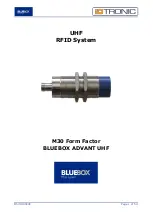
Chapter 4
Theory of Operation
© National Instruments Corporation
4-5
Lab-PC+ User Manual
Analog Input Circuitry
The analog input circuitry consists of two CMOS analog input multiplexers, a software-
programmable gain amplifier, a 12-bit ADC, and a 12-bit FIFO memory that is sign-extended to
16 bits.
One of the input multiplexers has eight analog input channels (Channels 0 through 7). The other
multiplexer is connected to Channels 1, 3, 5, and 7 for differential mode. The input multiplexers
provide input overvoltage protection of
±
45 V, powered on or off.
The programmable gain amplifier applies gain to the input signal, allowing an input analog
signal to be amplified before being sampled and converted, thus increasing measurement
resolution and accuracy. The gain of the instrumentation amplifier is selected under software
control. The Lab-PC+ board provides gains of 1, 2, 5, 10, 20, 50, and 100.
The Lab-PC+ uses a 12-bit successive-approximation ADC. The 12-bit resolution of the
converter allows the converter to resolve its input range into 4,096 different steps. This
resolution also provides a 12-bit digital word that represents the value of the input voltage level
with respect to the converter input range. The ADC itself has a single input range of 0 to +5 V.
Additional circuitry allows inputs of
±
5 V or 0 to 10 V.
When an A/D conversion is complete, the ADC clocks the result into the A/D FIFO. The A/D
FIFO is 16 bits wide and 512 words deep. This FIFO serves as a buffer to the ADC and provides
two benefits. First, any time an A/D conversion is complete, the value is saved in the A/D FIFO
for later reading, and the ADC is free to start a new conversion. Secondly, the A/D FIFO can
collect up to 512 A/D conversion values before any information is lost, thus allowing software
some extra time (512 times the sample interval) to catch up with the hardware. If more than
512 values are stored in the A/D FIFO without the A/D FIFO being read from, an error condition
called A/D FIFO overflow occurs and A/D conversion information is lost.
The A/D FIFO generates a signal that indicates when it contains A/D conversion data. The state
of this signal can be read from the Lab-PC+ Status Register.
The output from the ADC can be interpreted as either straight binary or two's complement,
depending on which input mode you select (unipolar or bipolar). In unipolar mode, the data
from the ADC is interpreted as a 12-bit straight binary number with a range of 0 to +4,095. In
bipolar mode, the data from the ADC is interpreted as a 12-bit two's complement number with a
range of -2,048 to +2,047. In this mode, the MSB of the ADC result is inverted to make it two's
complement. The output from the ADC is then sign-extended to 16 bits, causing either a leading
0 or a leading F (hex) to be added, depending on the coding and the sign. Thus, data values read
from the FIFO are 16 bits wide.
Data Acquisition Timing Circuitry
A data acquisition operation refers to the process of taking a sequence of A/D conversions with
the sample interval (the time between successive A/D conversions) carefully timed. The data
acquisition timing circuitry consists of various clocks and timing signals that perform this timing.
The Lab-PC+ board can perform both single-channel data acquisition and multiple-channel
Содержание Low-Cost Multifunction I/O Board for ISA...
Страница 89: ......
Страница 90: ......
Страница 91: ......
Страница 92: ......
Страница 93: ......
Страница 94: ......
Страница 95: ......
Страница 96: ......
Страница 97: ......
Страница 98: ......
Страница 99: ......
Страница 101: ......
Страница 102: ......
Страница 103: ......
Страница 104: ......
Страница 105: ......
Страница 106: ......
Страница 107: ......
Страница 108: ......
Страница 109: ......
Страница 110: ......
Страница 111: ......
Страница 112: ......
Страница 113: ......
Страница 114: ......
Страница 115: ......
Страница 116: ......
















































